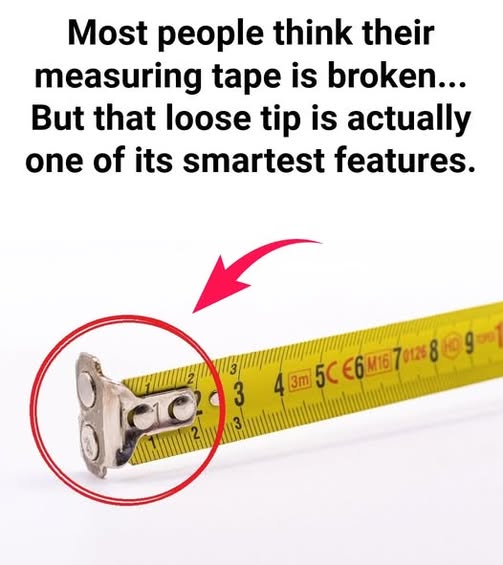If you’ve ever pulled out a measuring tape and noticed that the little metal tip at the end wiggles or slides back and forth, you might have thought something was wrong with it. It can look strange at first, and the natural reaction is to assume it’s loose or broken, because shouldn’t that end be fixed tightly in place to guarantee accurate measurements?

The truth is, that tiny bit of movement is not a defect—it’s an intentional feature, and one of the smartest pieces of engineering built into the tool. The loose tip is designed to move so your measurements stay precise whether you’re measuring the inside or outside of something. Without that wiggle, you’d have to adjust every measurement in your head to account for the tip’s thickness, which would be inconvenient and lead to more errors. The secret behind this lies in what’s called a “true zero” adjustment. The metal hook at the very end of your tape measure is not paper-thin; it has a thickness of about 1/16 of an inch.
That might not seem like much, but in measuring, even that small amount can change the accuracy of your results. To make sure your starting point is always correct, the hook is designed to slide in and out exactly that distance. Let’s break it down by the two most common types of measurements you might take. First, there’s the outside measurement—say you’re measuring the length of a board. You hook the tip over the edge and pull the tape toward you. In this case, the hook slides outward slightly, away from the body of the tape, so the measurement starts at the exact edge of the board, not the inside of the hook.
Then there’s the inside measurement, like when you’re figuring out the internal width of a drawer. You press the hook firmly against one wall and extend the tape to the other side. This time, the hook shifts inward, compensating for its own thickness so the starting point is still spot-on. That tiny bit of play in the hook is what allows both types of measurements to be equally accurate. If the hook didn’t move, you’d have to mentally subtract or add that 1/16 of an inch every time, and while that might sound easy, it’s just one more opportunity for human error, especially if you’re working quickly.
On a properly functioning tape measure, the movement should match the hook’s thickness—about 1/16 of an inch. If it moves much more than that or feels like it’s about to fall off, there’s probably damage. But if it shifts just a hair, that’s exactly what it’s supposed to do. The genius of this feature is in its simplicity. It’s not flashy, but it solves a problem most people don’t even realize exists until it’s explained. And it’s universal—you’ll find it on high-end contractor-grade tapes and on budget versions from the dollar store alike. Professionals use it daily without thinking about it, trusting that the “loose” end is quietly making their work more accurate and saving them from having to constantly adjust their math. Of course, not all wobbles are good wobbles.
If the tip of your tape measure is visibly bent, cracked, or hanging limp, it’s a sign the tape may need repair or replacement. A healthy loose tip should feel smooth and slightly springy, not floppy and detached. In some cases, you can tighten or loosen it slightly with a screwdriver if it feels off, but severe damage usually means it’s time for a new tape. The next time you use your measuring tape and notice that little piece shifting back and forth, give it some credit.
It’s quietly working to ensure your numbers are right, whether you’re building a bookshelf, hanging curtains, framing a wall, or renovating a kitchen. It’s one of those small, almost invisible design details that makes a big difference in accuracy. So if someone tells you their tape measure is broken because the tip moves, you can smile and say, “Nope—it’s supposed to do that. It’s smarter than it looks.” That bit of engineered wiggle is proof that sometimes the smallest features can have the biggest impact on getting the job done right.





